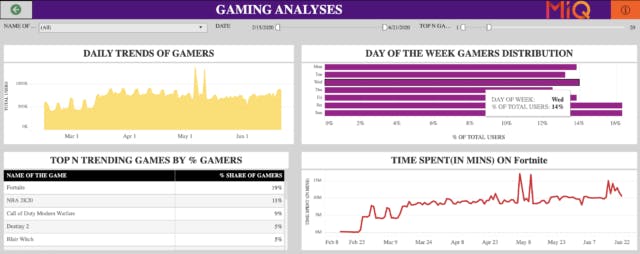
How a trader optimizes a gaming campaign
By Beki Chafer, Trader, MiQ London
The COVID-enforced lockdown has seen a massive rise in people playing computer games. According to our proprietary COVID-19 dashboard monitoring online activity, the number of people gaming peaked in April and May with a record of 1,379,552 total users in the USA tracking on the top 20 online games.
This growing gaming audience presents a major opportunity for gaming companies, which is why, according to Ad Age, “video games have more than doubled their ad spend since the start of the pandemic.”

Image 1: Daily Gaming Trends
For programmatic traders like me, gaming campaigns offer a unique trading opportunity to create more value for advertisers.
Our COVID-19 dashboard gives us the most up-to-date information around gaming trends, top trending games by percent, time spent on a specific game and even audience segmentation. These types of insights make it especially unique for us traders working on gaming campaigns. Using this information, we can then personalize campaign settings to maximize performance.
Daily Trends of Gamers

Image 2: Daily Trends Peak in users
What does a gaming campaign look like?
Gaming typically either promotes a new launch (such as a new game or gaming console) or a limited special offer such as a discount on a gaming title or a gaming bundle (a group of products available to buy at a reduced price). That means gaming campaigns are usually run in shorter bursts. It’s rare for gaming campaigns to become always-on campaigns, though it’s not unheard of.
A gaming campaign promoting a new product is usually defined by a pre-launch burst, which encourages consumers to pre-order the product before the launch date. In doing so, a consumer would usually get some kind of reward (like, receiving content not available when buying the game after launch or a small discount) which would be promoted on the advert.
This is then followed by a post-launch burst, letting the audience know that the product is available to purchase and play. These bursts will have different creative messages and potentially different budget allocations.
A campaign with a limited special offer usually also contains multiple bursts as offers are typically only available for a short period of time before swapping out into a new offer. (For instance, offering a discount on a particular game title each week). These types of gaming campaigns are usually targeted at gift-givers and held around key retail events such as Black Friday, Cyber Monday and Christmas.
Gaming campaigns are often volatile in unique ways. For example, if the message you’re promoting hasn’t been publicly announced until the start date of the campaign, you could be asked to pause before the campaign’s even begun. This would be due to a leak.
A leak in gaming refers to information about a particular upcoming event/promotion becoming available to the public before the gaming company intended. These sometimes trend highly and quickly on social media. If this happens, usually it would cause a delay in the start date or a revision of the campaign’s plan last minute. Revisions can include reduction in budget (a lot of players now know about the announcement and additional marketing isn’t always required) or a revision of flight dates.
Now that working from home is quickly becoming the norm, gaming is likely to see a spike in programmatic trading. It is important for gaming advertisers to have traders that understand not only the delivery of gaming campaigns, but the gaming campaign lifecycle.
To learn more how you can partner with MiQ to ensure your gaming campaigns programmatic campaigns exceed performance check out our blog on the impact of COVID-19 on gaming habits here and get in touch with us here.
- 1.1



